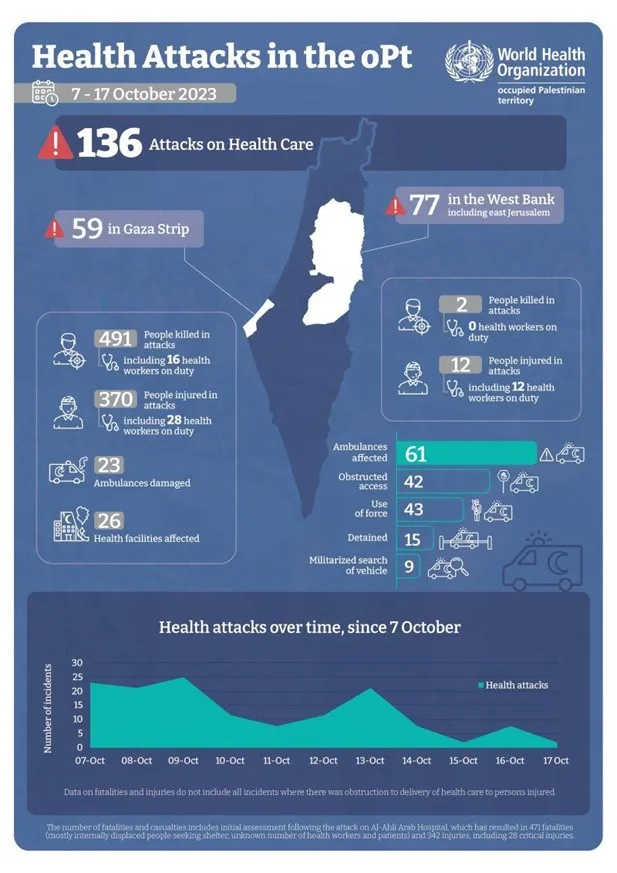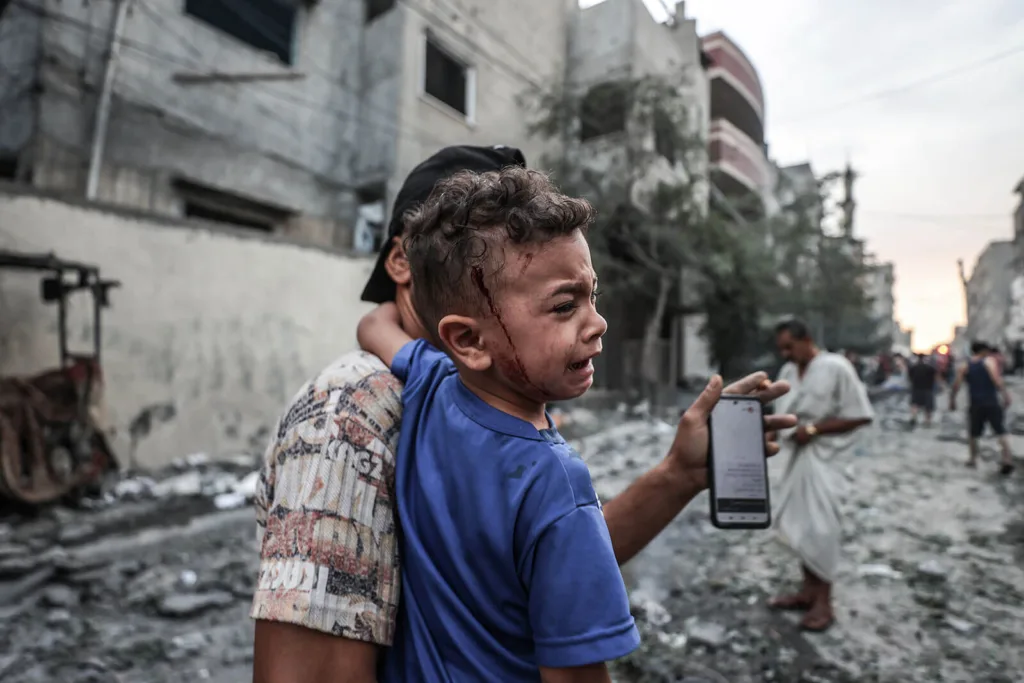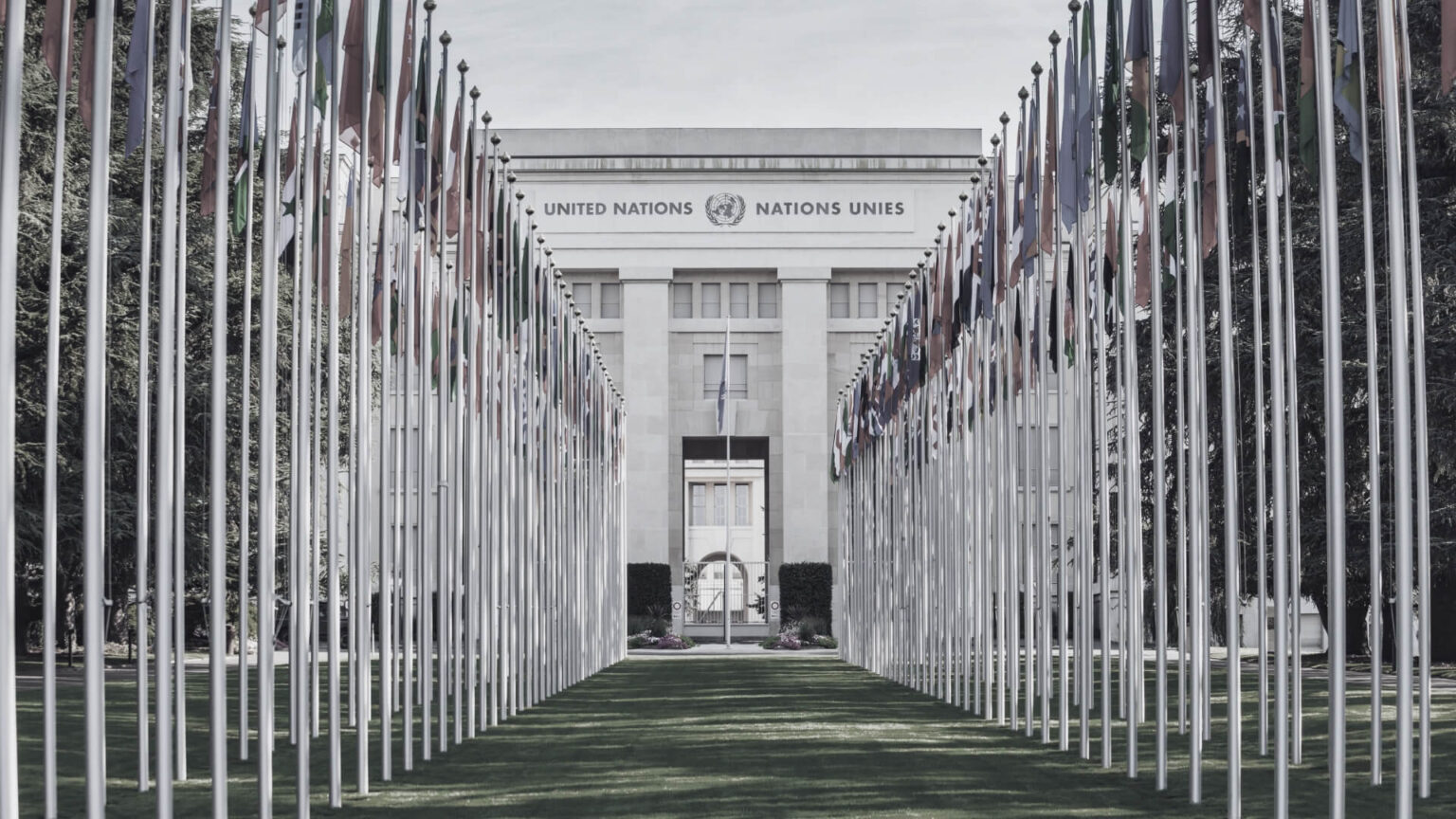The healthcare system has completely collapsed in Gaza
The Gaza Strip has witnessed years of air, sea, and land blockade, conflicts, and essential human needs shortages. Since Israel imposed a siege on the strip in 2007, the healthcare system has been greatly harmed, as Gaza has suffered from socio-economic decline and critical scarcity of clean water, safe food, electricity, and fuel supply and poor sanitation and waste management which, in consequence, greatly harm the health care system.
The recent continuous Israeli bombardment on Gaza in October 2023 resulted in the killing of over 5,000 people, at least 500 of them were killed in the Al-Ahli (Baptist hospital) massacre and injured more than 15000 people, according to the Palestinian Ministry of Health, and the numbers are still going on. Children represent more than 40% of the deaths.
Israel announced a complete cutoff of the fuel supply and electricity. Besides the acute medical supply shortage, lack of water supply, and hospitals and morgue overcrowding, these factors collectively exacerbate a devastating situation, resulting in a health disaster and a severe environmental crisis.

Gaza’s health facilities status
Medicals and WHO have reported that the hospitals are drastically running out of beds. Despite maximizing the volume of some emergency departments and ICUs, they are still below the actual needs.
These consequences affect, to mention a few, the other patients in ICUs, newborn babies who may need incubators, patients with life-threatening conditions, and those who need emergency surgery.
With no aid currently coming from outside Gaza, the available stocks of essential medical supplies and the additional supplies from the private sector and NGOs provided to the operating hospitals will be enough for days only. Keeping in mind overcrowding is another issue compounding the burden on the health facilities, as the population of Gaza is approximately 2.1 million inhabitants in an area of 356 sq km.
Originally, the strip had 14 governmental hospitals, 11 NGO hospitals, and 22 primary health care centers belonging to UNRWA. These health facilities were greatly affected by the previous wars, and the continuous blockade has weakened their physical infrastructure, disrupted their carrying capacity, and reduced the quality of medical services.
Recently, Israel gave orders of evacuation to 23 hospitals in North Gaza, which have a capacity of 2,000 beds. The two operating governmental hospitals exceed their total capacity of 760 beds with many wounded people who have not received medical care yet. These orders are refused by WHO and UN and they appeal for immediate reversal of the orders.
As of 24 October, 12 hospitals and 32 health centers are out of service with lack of fuel in rest of the hospitals to run.
The current health disaster could agitate any well-established healthcare system in the world, then what about an already exhausted healthcare system existing in Gaza?
Healthcare workers and ambulance officers
Hospitals, healthcare workers, and ambulance officers are targets of the continuous air strikes.
Ten ambulance officers were killed, and twenty ambulance vehicles were shattered, according to the Palestinian Health Ministry.
WHO declared that 34 attacks on health facilities in Gaza took place since the start of air strikes, leading to the death of 11 healthcare workers on duty and 16 injuries.
UNRWA said that 12 of their staff were among the fatalities.
According to International Law and Rule 25, “Medical personnel exclusively assigned to medical duties must be respected and protected in all circumstances”. The International Committee of the Red Cross (ICRC) has asserted that the protection of healthcare workers in a war zone is crucial.
The challenging situation of the work environment, the dwindling of resources, and the fact that they are at risk encounter great stress on healthcare personnel, which in turn negatively affects the health services that must be provided to patients.

Access to Health
Wounded patients
The WHO Constitution (1946) stated “…the highest attainable standard of health is a fundamental right of every human being.” The continuous huge influx of wounded made the managers of hospitals feel compelled to prioritize resuscitation emergency care and the patients whom the medical staff could deal with according to the available medicines, consumables, and medical devices.
The damaged and unsafe roads and the absence of safe corridors hinder the movement of wounded and sick people to access medical care.
Primary care services and non-communicable diseases (NCD)

Only one-third of the UNRWA health centers can provide primary healthcare services four hours a day(from 9:00 to 13:00) to critically outpatient cases. A total of 60,900 patients with NCD are registered within UNRWA which could barely provide treatment for some of them.
The overstretched hospitals have limited response capacity for the management of patients with non-communicable diseases and common infections.
A statement by the Arab Society of Paediatric Endocrinology and Diabetes (ASPED) expressed their concerns regarding the safety and well-being of children and adolescents with endocrine conditions such as diabetes and adrenal insufficiency who face life-threatening complications due to the persistent bombings and targeting of health facilities.
Short-term health conditions:
Drinking biologically or chemically contaminated water may transmit acute hepatitis A virus in addition to cholera, shigella, and salmonella bacterial infections that cause severe diarrhea and dehydration. The surrounding circumstances between Palestine and Israel do not preach to the prevention of these diseases like the lack of vaccines or at least rehydration management.
RAND has reported that waterborne infections constitute 25% of diseases in Gaza. UNICEF declared that diarrhea caused death in 12% of infants and children in 2009. Additionally, in 2016, the WHO reported that consuming unclean water resulted in more than one-fourth of all diseases in Palestine.
Viral meningitis outbreaks were observed in infants and children in the years 1997, 2004, 2013, and 2016. Malnutrition, living in tents, and population displacement may lead to suffering leishmaniases. Moreover, hand washing procedures for surgeons and health care staff can’t be ignored, for prevention of wound infections.
Long-term consequences of the destructed health system in Gaza:
Displacement of populations in wars may lead to epidemic flares. Outbreaks of measles and rubella were seen after twenty years of wars like during the GULF war, the Federation of Bosnia and Herzegovina, and in the prolonged siege in Canton of Sarajevo due to deterioration of vaccination programs and vaccines cold chains.
Furthermore, population displacement during wars caused a poliovirus variant in Pakistan to appear in other countries like the Gaza Strip, Israel, Egypt, and the West Bank, which eventually emerged in 2013 as a poliomyelitis outbreak in Syria.
Notably, malnutrition caused by wars results in both short and long-term burdens in children as shown in a cross-sectional study conducted in Sudan. Short-term consequences are observed in increasing mortality and morbidity while long-term results are observed in psychological and physical weaning leading to low societal productivity.
Cancer patients

Statistics from Gaza’s Ministry of Health show that there are more than 9,000 cancer patients in the strip. Many claims earlier this year had been made to organizations and institutions to make efforts toward affording treatments and medical services to cancer patients.
This war doubled their already existing struggles with the frequent shortage of medications and the absence of medical services like radiological therapy and nuclear scans.
The Palestinian-Turkish Friendship Hospital is the only cancer center in the strip. Now it is operating on a single backup generator, with fuel only enough for days.
Furthermore, population displacement during wars caused a poliovirus variant in Pakistan to appear in other countries like the Gaza Strip, Israel, Egypt, and the West Bank, which eventually emerged in 2013 as a poliomyelitis outbreak in Syria.
Notably, malnutrition caused by wars results in both short and long-term burdens in children as shown in a cross-sectional study conducted in Sudan. Short-term consequences are observed in increasing mortality and morbidity while long-term results are observed in psychological and physical weaning leading to low societal productivity.
Maternal Health

Currently, there are 50,000 pregnant women in Gaza, and 5,522 are expected to deliver in the next month with extreme challenges to accessing safe delivery services.
A study conducted by researchers from the Islamic University of Gaza, the Palestinian Ministry of Health, and UNFPA after the war of 2014 stated that 22% of the cases of maternal mortality in the study were impacted by the events of the war as access to medical care became difficult, mainly due to unsafe roads. The conditions of other cases were worsened by the war.
Mental Health
Adults
71% of adults in Gaza screen positive for depression. This conclusion came from a study done by the Palestinian Central Bureau of Statistics (PCBS), the World Bank, ISDC, and Zentrum Überleben (2023).
The study also showed that poor mental health is strongly associated with exposure to violent conflict and traumatic events.

Children
Noura Warsi, in her study, published in 2023 – of the children’s mental health after the war in Gaza, clarified that children expressed changes in behavior like anorexia, nocturnal enuresis, and nightmares.
She also found that many of Gaza’s children were diagnosed with new-onset separation anxiety, posttraumatic stress disorder, generalized anxiety, and suicidal ideation.

Another study was done by Save The Children to compare the mental well-being of Gaza’s children in 2022 to the results of a similar study conducted in 2018. They found a massive increase in children who reported feeling fearful (84% compared to 50% in 2018), nervous (80% compared to 55%), sad or depressed (77% compared to 62%) and grieving (78% compared to 55%).
Pre and postnatal women
A study conducted by Punamäki RL and others in 2018, found that exposure to war trauma was associated with high levels of maternal mental health and complications during pregnancy and with increased postpartum mental health symptoms.
International Humanitarian Law

The rules of the International Humanitarian Law are made to decrease harm and protect civilians, health, and humanitarian workers. The law criminalizes any interference with health care, like blocking the passage of civilians, wounded, and sick people to a safe place. The foundation of the rules is to avoid targeting hospitals, other health facilities, ambulances, and civilian infrastructure.
Future recommendations should be followed to decrease the impact of the war on health.
1- To end sieges that endanger the lives of civilians by depriving them of goods essential for their survival.
2- Immediately re-supply the vulnerable populations in Gaza strips with basic needs such as electricity, food, fuel, and sanitary water.
3- Regarding health status
Continuous Supply of Essential Medical Resources with medicines, medical equipment, and supplies necessary for treating injuries, infections, and chronic health conditions
Implementing well-organized distribution systems and stockpiling essential resources in secure locations can help ensure that healthcare providers have access to the necessary tools to deliver timely and appropriate medical care.
Protection of Healthcare Facilities and Personnel; International humanitarian laws should be strictly enforced to prevent the targeting and destruction of medical facilities, as well as attacks on healthcare workers. By establishing safe zones and protocols that safeguard healthcare infrastructure, we can mitigate the impact of war on the healthcare system and ensure that medical professionals can continue to provide essential care to those in need.
Strengthening healthcare infrastructure by investing in hospitals, clinics, and medical facilities, ensuring they are well-equipped and staffed adequately to handle the surge in medical emergencies during times of conflict.
Mental Health Support and Psychological Rehabilitation; by providing comprehensive mental health support and psychological rehabilitation services. Additionally, training and preparedness programs for healthcare professionals can greatly enhance their ability to respond effectively to urgent situations.
1. https://civil-protection-humanitarian-aid.ec.europa.eu/what/humanitarian-aid/international-humanitarian-law_en
2.https://www.moh.gov.ps/portal/category/%d8%a7%d9%84%d8%ad%d8%b1%d8%a8-%d8%b9%d9%84%d9%89-%d8%ba%d8%b2%d8%a9/
3. https://www.unrwa.org/activity/health-gaza-strip
4. https://www.msf.org/hospitals-are-overwhelmed-catastrophic-situation-gaza
5. https://www.unocha.org/news/un-relief-chief-aid-access-gaza-main-priority-now
6.https://www.researchgate.net/publication/316112446_Maternal_Pre-_and_Postnatal_Mental_Health_and_Infant_Development_in_War_Conditions_The_Gaza_Infant_Study
7.https://ajph.aphapublications.org/doi/10.2105/AJPH.36.11.1315
8.https://www.unfpa.org/sites/default/files/resource-pdf/UNFPA-Situation-Report_Palestine_13Oct2023.pdf
9. https://isdc.org/publications/mental-health-in-the-west-bank-and-gaza/
10.https://www.savethechildren.net/news/after-15-years-blockade-four-out-five-children-gaza-say-they-are-living-depression-grief-and
11.https://scholarworks.wmich.edu/cgi/viewcontent.cgi?article=4702&context=honors_theses
12. https://www.msf.org/unconditional-humanity-needs-be-restored-gaza
13. https://www.csis.org/analysis/war-gaza-and-death-two-state-solution
14.https://apps.who.int/gb/ebwha/pdf_files/WHA75/A75_26-en.pdf
15. https://www.unicef.org/mena/press-releases/fifteen-years-blockade-gaza-strip
16.https://www.ncbi.nlm.nih.gov/pmc/articles/PMC1472271/
17. https://asped.net/
18.https://www.rand.org/pubs/research_repormlts/RR2515.ht.
19.https://wwwnc.cdc.gov/travel/yellowbook/2024/infections-diseases/hepatitis-a
20. https://www.who.int/news-room/fact-sheets/detail/leishmaniasis
21.https://www.ochaopt.org/content/study-warns-water-sanitation-crisis-gaza-may-cause-disease-outbreak-and-possible-epidemic

